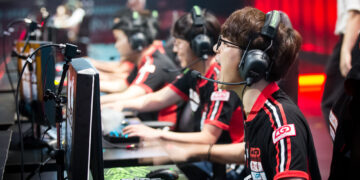Tapping into the Digital Goldmine: Unleashing the Potential of Monetizing the Explosive eSports Phenomenon
In the ever-evolving landscape of the digital world, a phenomenon has taken centre stage and captured the attention of millions: eSports. Defined as competitive video gaming, eSports has witnessed an explosive surge in popularity, transforming from a niche hobby into a global sensation.
With its rapid growth in recent years, eSports has emerged as a lucrative industry that transcends traditional boundaries, captivating both players and spectators alike. As such, this article aims to delve into the depths of this digital arena, exploring innovative ways to monetize the eSports boom.
Definition of eSports and its Rapid Growth in Recent Years
eSports is much more than mere gameplay; it is an organized competitive space where professional gamers exhibit their skills on various platforms such as PCs, consoles, and mobile devices.
These competitions attract vast audiences who tune in online or attend live events to witness intense battles unfold between teams or individual players.
The growth trajectory of eSports has been nothing short of remarkable; it has swiftly evolved from underground tournaments into multimillion-dollar events that rival traditional sports spectacles. In recent years, we have seen burgeoning interest from diverse demographics around the globe.
The numbers speak for themselves: according to Newzoo’s Global Esports Market Report 2021, there are currently over 474 million enthusiasts and occasional viewers of eSports worldwide.
This figure is expected to exceed 577 million by 2024—an astonishing testament to the meteoric rise of this digital phenomenon.
Overview of Potential for Monetization in the Digital Arena
Beyond its undeniable popularity and widespread appeal lies an enticing aspect for entrepreneurs and businesses—the immense potential for monetization within the realm of eSports. With its massive audience base comprising passionate gamers and dedicated fans, eSports offers unique opportunities to generate revenue through various channels.
From sponsorships and brand partnerships to advertising revenue, the possibilities for leveraging eSports as a lucrative venture are vast. In addition, innovative approaches such as in-game purchases and microtransactions, merchandising beyond traditional merchandise, crowdfunding initiatives for prize pools, and subscription-based models for exclusive content access have proven to be successful avenues for driving revenue within the eSports industry.
This article will delve into these diverse monetization strategies, providing insightful analysis and real-life examples to shed light on how businesses can cash in on the digital arena of eSports.
By exploring both traditional and innovative methods of monetization, we aim to equip entrepreneurs with the knowledge necessary to navigate this burgeoning industry’s potential.

Understanding the eSports Boom
Exploring the reasons behind the popularity of eSports
The meteoric rise of eSports can be attributed to a convergence of several factors that have driven its popularity to unprecedented heights. Firstly, the establishment and growth of online gaming communities have played a pivotal role.
These communities serve as virtual gathering spaces for gamers from all over the globe, fostering camaraderie, competition, and a sense of belonging.
The advent of streaming platforms like Twitch has further bolstered the reach and visibility of eSports by providing a live broadcasting platform for players to showcase their skills to a massive audience.
Rise of online gaming communities and streaming platforms
Online gaming communities have revolutionized how gamers interact with each other. They offer players an opportunity to connect with like-minded individuals who share their passion for gaming.
Through these communities, gamers can form teams or join existing ones, participate in tournaments, exchange strategies and tips, and engage in friendly banter.
Streaming platforms such as Twitch have further amplified this sense of community by enabling players to broadcast their gameplay live or watch others play in real time.
This not only enhances the social aspect but also provides valuable learning experiences for novice players seeking guidance from more experienced individuals.
Global accessibility through internet connectivity and mobile devices
The widespread availability of high-speed internet connectivity coupled with advancements in mobile technology has significantly contributed to the global accessibility of eSports.
Players no longer need expensive gaming consoles or powerful computers; they can now compete using smartphones or tablets, making them accessible to millions around the world.
This ubiquity has opened up new avenues for engagement while bridging geographical barriers that were once limitations on traditional sports.
Competitive nature and spectator appeal of eSports events
One cannot overlook the intensely competitive nature and spectator appeal that lies at the heart of eSports events’ popularity. eSports tournaments and championships provide a platform for professional gamers to showcase their skills, drive, and dedication on a grand stage.
The thrill of watching highly skilled players engage in strategic battles, executing lightning-fast reflexes and displaying unrivalled teamwork is undeniably captivating.
This spectator appeal has attracted not only gaming enthusiasts but also casual viewers who seek entertainment in the form of thrilling competitions, akin to traditional sports like football or basketball.
The understanding of these factors is crucial for comprehending the eSports boom and its potential for monetization. By recognizing the driving forces behind its rapid growth, various stakeholders can tap into innovative methods to capitalize on the immense popularity of eSports.

Sponsorships and Brand Partnerships: Leveraging the Engaged eSports Audience
One of the most prominent ways to monetize in the rapidly expanding eSports industry is through sponsorships and brand partnerships. Companies across various industries have recognized the immense potential of eSports as a marketing channel to reach a highly engaged audience.
By associating their brand with popular teams, tournaments, or individual players, companies can tap into the passionate fanbase that eSports commands. Brands leverage eSports by aligning themselves with players or teams that resonate with their target demographic.
This allows them to connect with a passionate and dedicated audience who are receptive to promotional messages.
For example, energy drink giant Red Bull has successfully partnered with numerous eSports organizations like Team SoloMid and Cloud9, capitalizing on their global reach and highly engaged fanbases.
Examples of Successful Sponsorships in Major Tournaments
The impact of effective sponsorships is vividly seen in major tournaments where brands actively invest in reaching the millions of viewers spectating online or attending live events. One notable example is Intel’s partnership with ESL (Electronic Sports League).
Through this collaboration, Intel has become synonymous with high-performance gaming hardware as they provide cutting-edge technology for ESL events worldwide. Their branding exposure during tournaments not only promotes their products but also reinforces their position as a trusted leader within the industry.
Advertising Revenue: Amplifying Reach through Live Streams and Content Platforms
Another avenue for monetization within eSports lies in advertising revenue generated from live streams and content platforms. As these digital arenas attract large audiences, companies recognize the value of placing ads strategically throughout broadcasts. The role of ad placements within eSports content cannot be overstated.
From pre-roll ads before streams start to product integrations within gameplay segments, advertisers have found innovative ways to capture viewers’ attention.
Brands have also explored collaborations with popular content creators, integrating their products or services seamlessly into the streaming experience and leveraging their influence to promote brand awareness.
Case Studies on Successful Advertising Campaigns within eSports
Several case studies highlight the effectiveness of advertising campaigns within eSports. One notable example is the partnership between Doritos and Twitch, a popular streaming platform for gaming content.
Doritos launched “Unlock The Stream,” a campaign where viewers unlocked exclusive Twitch emotes by purchasing Doritos products. This not only drove sales but also increased audience engagement and solidified Doritos’ connection with the gaming community.
Similarly, Riot Games, the publisher of League of Legends, partnered with Mastercard to create unique experiences for fans during their flagship tournament, Worlds.
By providing exclusive benefits such as behind-the-scenes access or meet-and-greets with professional players, Mastercard successfully capitalized on the enthusiasm surrounding eSports events while building brand loyalty among fans.
In-game purchases and microtransactions
Exploring how game developers generate revenue through virtual goods
In the ever-evolving landscape of eSports, one of the most prevalent and innovative ways to monetize the digital arena is through in-game purchases and microtransactions. Game developers have tapped into the psychology of players by offering virtual goods that enhance their gaming experience or provide aesthetic upgrades.
These items, often available for purchase within the game itself, can range from new weapons and power-ups to cosmetic items such as skins, outfits, or emotes.
By carefully crafting a system that entices players to spend real money on these virtual assets, developers not only generate significant revenue but also create a sense of exclusivity and personalization for players.
The impact of loot boxes, skins, and cosmetic items on player spending habits
One particularly lucrative aspect of in-game purchases is the introduction of loot boxes – randomized virtual containers that offer a chance at obtaining rare or valuable items. The allure of uncertainty combined with desirable rewards has proven to be irresistible for many gamers.
However, this practice has sparked debates about its resemblance to gambling mechanics and potential negative consequences such as addiction or exploitative business practices. Nevertheless, there is no denying that these tactics have been highly effective in enticing players to spend more on in-game purchases.
The introduction of skins and cosmetic items further amplifies the potential for revenue generation in eSports. Players desire individuality within their gaming experience and are willing to invest in unique visual enhancements for their avatars or weapons.
Skins offer customization options that allow gamers to stand out from others while participating in tournaments or streaming their gameplay online. This desire for self-expression creates opportunities for collaboration between game publishers or teams with external brands interested in promoting themselves within this lucrative market.
Merchandising opportunities beyond traditional merchandise
Unique product collaborations with game publishers or teams
Innovative monetization strategies within the eSports industry extend beyond the virtual realm and into the realm of physical merchandise. With the rising popularity of eSports, game publishers and teams have embraced collaborations with various brands to create unique, co-branded products.
These partnerships often result in limited edition clothing lines, accessories, or even gaming peripherals that appeal to both gamers and fans alike.
By leveraging the loyal following of their respective games or teams, these collaborations not only generate revenue but also strengthen brand loyalty by providing fans with exclusive items that represent their passion for eSports.
Limited edition collectables tied to specific events or achievements
Another avenue for monetization lies in limited edition collectables tied to specific events or achievements within eSports. These items hold significant value for avid collectors and passionate fans who seek tangible memorabilia from their favourite games or tournaments.
Whether it is a signed jersey from a championship-winning team, a replica weapon from a popular game franchise, or an art book showcasing concept designs and illustrations, these limited edition collectables serve as mementoes of unforgettable moments in eSports history.
By offering these highly sought-after items through auctions, pre-orders, or special promotions, game developers and tournament organizers can tap into an additional revenue stream while providing an opportunity for fans to own something truly unique.
As the eSports industry continues its meteoric rise in popularity and global reach, opportunities for innovative monetization strategies abound. In-game purchases and microtransactions capitalize on players’ desire for customization and personalization within their gaming experience.
Meanwhile, merchandising ventures go beyond traditional merchandise by offering unique collaborations with external brands and limited edition collectables tied to specific events or achievements.
By embracing these innovative ways to monetize the eSports boom comprehensively yet ethically, stakeholders within this digital arena can continue fueling its growth while ensuring a sustainable financial future for all involved parties.
Emerging Trends in Monetizing eSports
Crowdfunding initiatives for prize pools
Unleashing the Power of the Community The advent of crowdfunding has transformed the landscape of tournament prize money in the eSports industry. Crowdfunding allows fans and supporters to contribute directly to the prize pool, fostering a sense of community involvement and ownership.
Through platforms like Kickstarter and IndieGoGo, fans can donate varying amounts, unlocking exclusive rewards based on their contribution level.
This innovative approach has led to unprecedented growth in prize pools for tournaments, enabling organizers to offer substantial cash prizes that attract top-tier talent from around the world.
The Dota 2 International is a shining example, with its record-breaking crowdfunding campaign that amassed an astounding $34 million in 2019. These initiatives demonstrate that when fans unite behind a shared passion for eSports, extraordinary things can happen.
Subscription-based models for exclusive content access
Unlocking the Gates to Exclusive Experiences In recent years, subscription-based models have gained significant traction in monetizing eSports by offering exclusive content access.
Premium memberships provide subscribers with additional benefits such as early access to game updates, behind-the-scenes footage, exclusive interviews with players and teams, and unique in-game items not available to non-subscribers.
This approach not only generates recurring revenue but also strengthens fan loyalty through an enhanced sense of belonging and exclusivity.
Twitch’s “Twitch Prime” is a prime example (no pun intended) of this model’s success; with a subscription fee, users gain numerous benefits like ad-free viewing experiences and free monthly channel subscriptions which incentivize them to stay engaged within the platform.
Conclusion
The rapidly evolving arena of eSports offers immense opportunities for monetization through innovative methods. Crowdfunding initiatives have revolutionized tournament prize pools by harnessing the power of passionate communities who rally together to support their favourite games and players.
Moreover, subscription-based models provide a gateway to exclusive content access, creating a sense of belonging and loyalty among fans.
As the eSports industry continues to grow, we can expect even more groundbreaking strategies for generating revenue and capitalizing on this digital phenomenon. With an ever-expanding fan base and increased engagement, the future of eSports monetization looks promising, with endless possibilities yet to be explored.





















